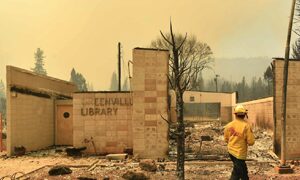- About
- Network
- Community
- Initiatives
- News
- Events
- Blog
- Publications

Responding to disasters: the CENIC community’s role in response and recovery
Categories K-12 Libraries RENS & NRENS The CENIC Community
Fires, floods, earthquakes, and now pandemics have become part of the landscape for Californians in this second decade of the 21st Century. No longer are any of these events unprecedented or unexpected. Today the question is whether our experiences have prepared us to respond.
In an engaging discussion during CENIC’s 2022 conference, school and library leaders from San Diego, Sacramento, and El Dorado County noted that their connections to CalREN were key to their ability to creatively support their communities’ recovery from disasters in the last several years.
Migell Acosta, Director of the San Diego County Library; Carolyn Brooks, Director of the El Dorado County Library; Jerry Jones, Executive Director of Technology Services with the Sacramento County Office of Education; and Terry Loftus, Assistant Superintendent and Chief Information Officer with the San Diego County Office of Education shared their experiences and recommendations for preparation planning with attendees.
Each speaker said that when disasters strike, connection and communications are core to recovery. Each leader learned the importance of network redundancy for ensuring that the network connections used by the community and first responders alike remain up and running. After all, fiber and copper can melt in the intense heat of a wildfire, requiring innovative workarounds to sustain connectivity.
“It’s clear we can’t predict the full range of events that can have an impact on our everyday lives,” said Louis Fox, CENIC CEO. “But we can learn from the experiences of our community members while leveraging our engineering expertise and CalREN infrastructure to effectively respond when needed.”
Tips for Network-Enabled Fire Response and Recovery
Communities and responders benefited greatly from CENIC engineers, who helped develop and support creative responses as the Camp and Caldor fires raged in 2018 and 2021 respectively. Among the recommendations made was to consider supporting multiple paths using different vendors, as most county offices of education and main libraries are node sites for their districts or regions.
Another option is for school districts to consider secondary Internet connections if multiple paths are not available. That option, however, requires a networking team with advanced BGP routing skills and supportive leadership willing and able to invest the resources needed to help their team develop those skills.
Other recovery plan tips include using cloud-based email in lieu of on-premises services, backing up data and testing restoration, having support contracts for all equipment, and ensuring generators have public safety power shut-offs and can serve the entire building beyond just the data center.
Pandemic Response: Extending Networks Using Wireless and Mobile
The pandemic presented a different challenge – how to extend Wi-Fi to public spaces beyond buildings for students. “When nearly 6 million K-12 students had to transition to distance learning in 2020, CENIC was there to provide support. In San Diego County, this meant the distribution of tens of thousands of mobile Wi-Fi hotspots to students,” said Terry Loftus. “CENIC provided the network infrastructure that enabled us to work with vendor partners, such as Verizon, to route traffic from student hotspots through our county office of education infrastructure. This enabled us to provide centralized traffic filtering for devices that were no longer on physical school campuses, and thus not protected from malicious sites and/or objectionable content normally filtered at school sites."
In addition, districts and libraries creatively leveraged grants from vendors to use external wireless antennas to provide Wi-Fi in school and library parking lots as well as nearby parks. Some built private LTE networks using existing wireless towers and CBRS spectrum, although this was difficult, expensive, and provided only a relatively short range of two to three miles.

One very creative mobile solution was implemented by the El Dorado County Library, which used Wireless on Wheels vans to visit apartment complexes, parks, and shopping centers on a rotating schedule to offer connectivity to community members where they lived and worked. By using Cradlepoint IBR900 routers, dual SIM cards to double the bandwidth, and Yeti batteries with solar chargers, the Wireless on Wheels vans are a creative and resilient response to predictable future events that can be deployed quickly and ubiquitously even in the hardest-to-serve areas.
All panelists agreed that what were once considered unexpected disasters should today be regarded as expected and hence require advance planning. Responders must recognize that reacting to emerging disasters requires hours, not days. Sites and staff will need to be evacuated, frequently in extremely hazardous conditions. Both power and connections will fail at some point. And all community plans need to prepare for long-term recoveries that are managed by exhausted people.
After all, as the presenters noted, no crisis is over when the emergency vehicles drive away.
To learn more about the details of each panelist’s experiences and their advice for networking professionals who seek to empower their communities’ disaster response, you can link to the presentation here.
Related blog posts
The Venue is the World: CENIC Helps SFJAZZ Share Music with Everyone
Learn how Mount Allen shares musical experiences with the public through his role at San Francisco Jazz (SFJAZZ), which uses CENIC infrastructure to livestream performances to classrooms and libraries across the state.
Adaptive Teaching and Learning: Artificial Intelligence in the K-12 Environment
VCOE's Julie Judd and Dana Thompson address using AI in the K12 classroom at CENIC's Biennial conference "The Right Connection," touching on adaptive teaching, administration, and privacy.


